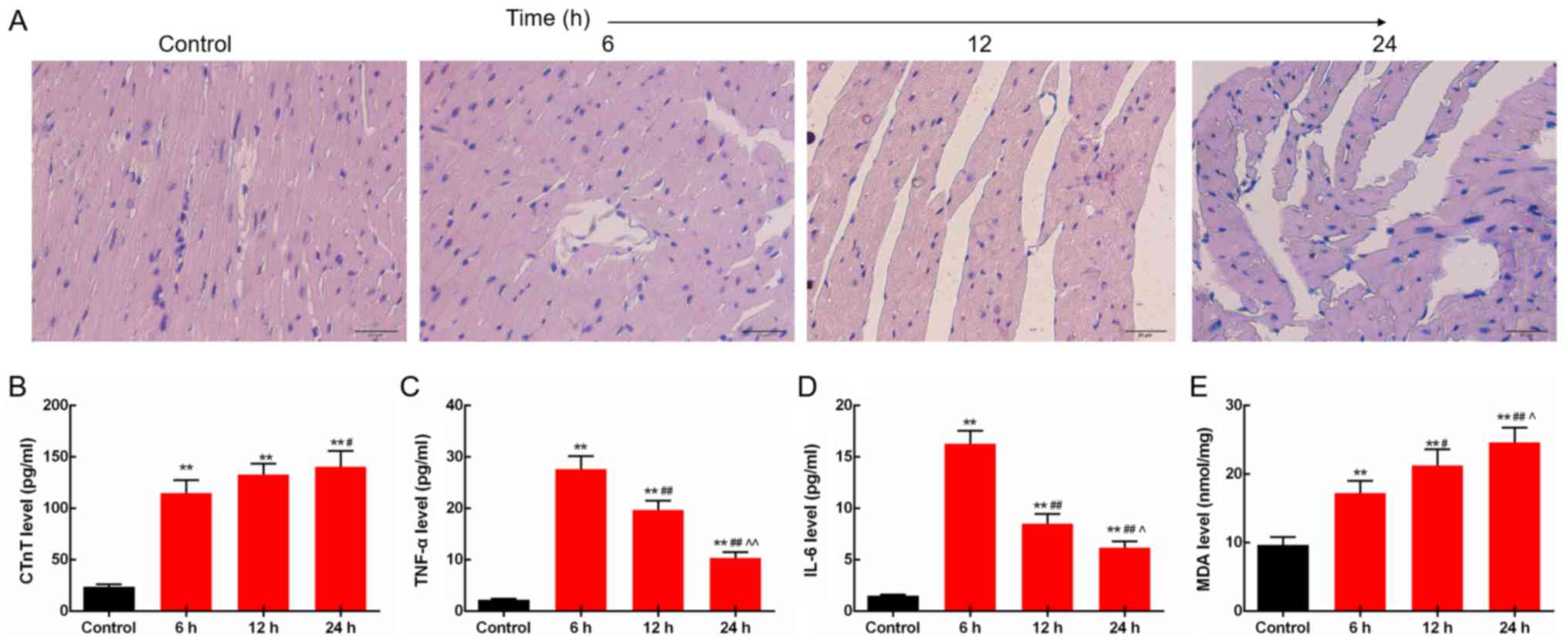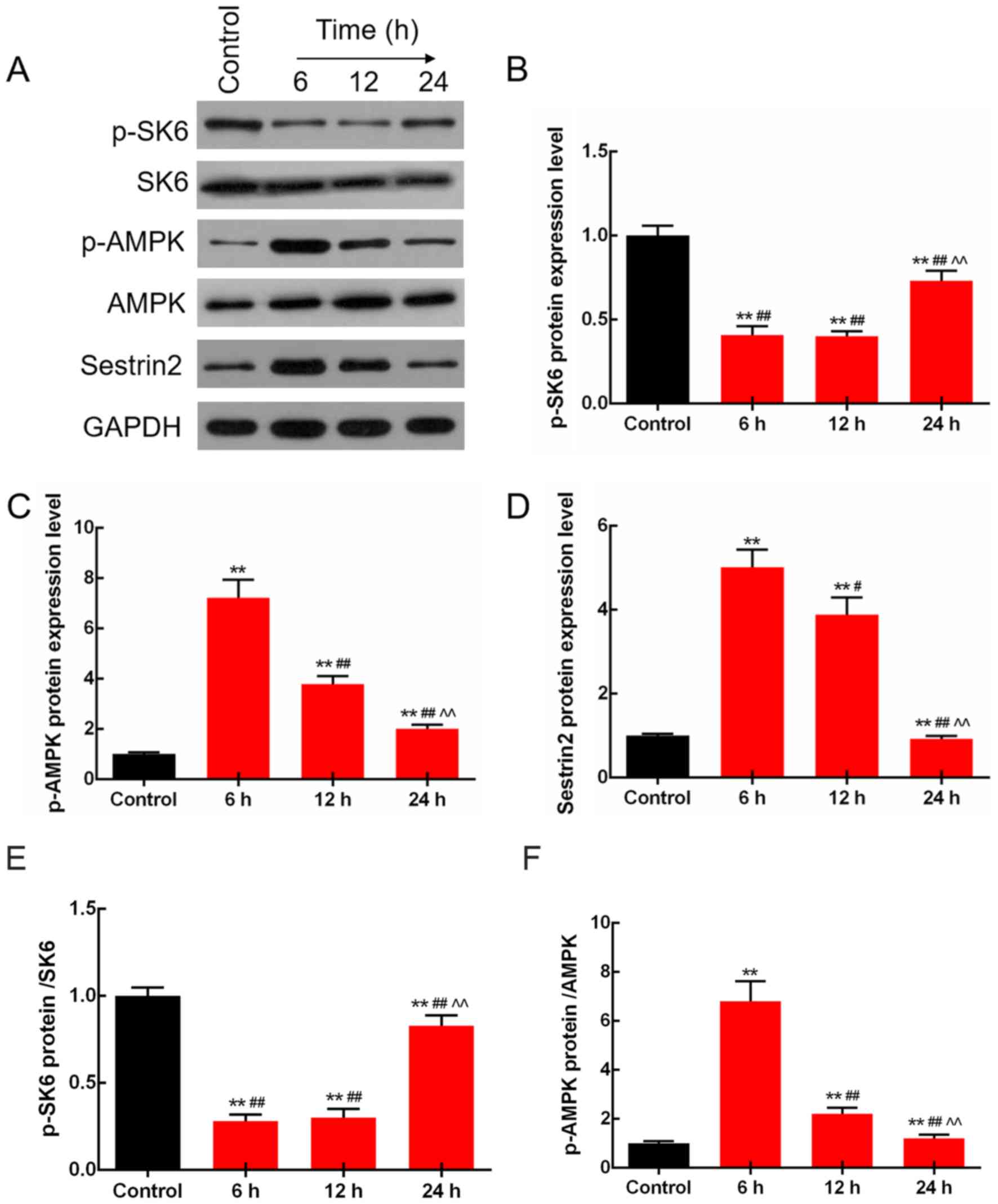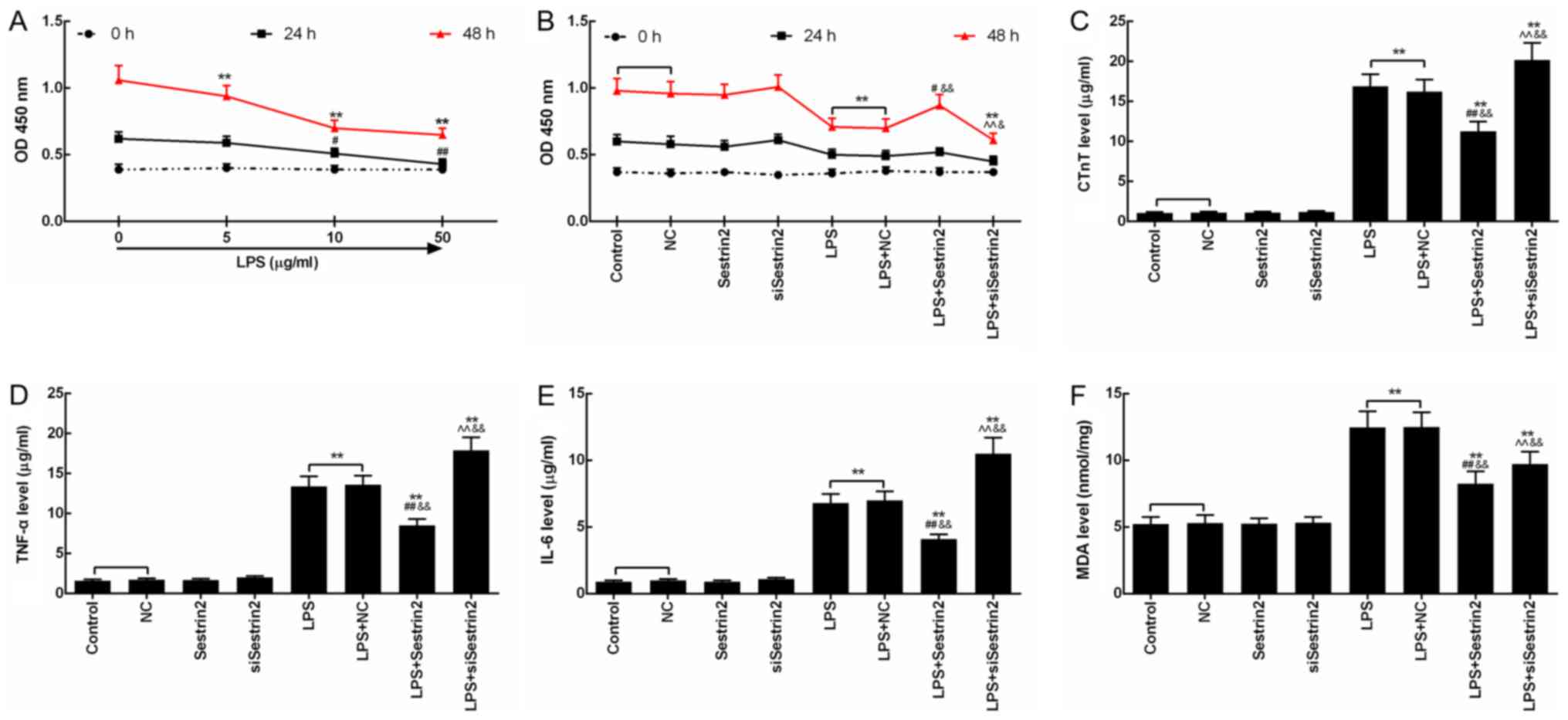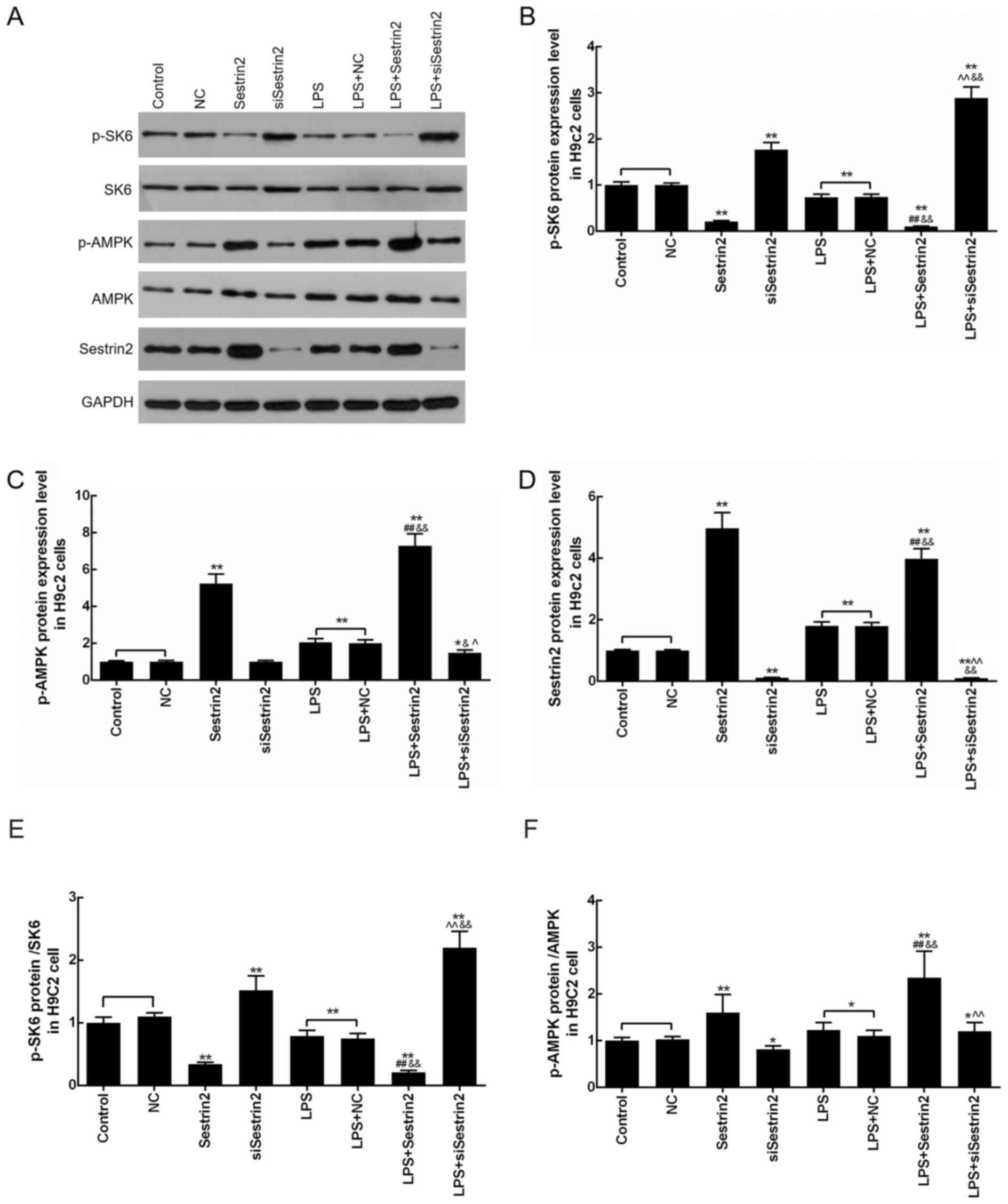|
1
|
McNevin C, McDowell R, Fitzpatrick F,
O'Sullivan R and Wakai A: The prevalence of severe sepsis or septic
shock in an irish emergency department. Ir Med J.
111:6922018.PubMed/NCBI
|
|
2
|
Koivikko P, Arola O, Inkinen O and
Tallgren M: One-year survival after inhospital cardiac arrest-does
prearrest sepsis matter? Shock. 50:38–43. 2018. View Article : Google Scholar : PubMed/NCBI
|
|
3
|
Ruangchan S, Chusri S, Saengsanga P,
Kiamkan N, Phunpairoth P and Chayakul P: Clinical outcomes of
community-acquired severe sepsis after implementation of a simple
severe sepsis fast track. J Med Assoc Thai. 99:877–885.
2016.PubMed/NCBI
|
|
4
|
Gao M, Wang X, Zhang X, Ha T, Ma H, Liu L,
Kalbfleisch JH, Gao X, Kao RL, Williams DL and Li C: Attenuation of
cardiac dysfunction in polymicrobial sepsis by MicroRNA-146a is
mediated via targeting of IRAK1 and TRAF6 expression. J Immunol.
195:672–682. 2015. View Article : Google Scholar : PubMed/NCBI
|
|
5
|
Walley KR: Sepsis-induced myocardial
dysfunction. Curr Opin Crit Care. 24:292–299. 2018. View Article : Google Scholar : PubMed/NCBI
|
|
6
|
Fattahi F, Frydrych LM, Bian G, Kalbitz M,
Herron TJ, Malan EA, Delano MJ and Ward PA: Role of complement C5a
and histones in septic cardiomyopathy. Mol Immunol. 102:32–41.
2018. View Article : Google Scholar : PubMed/NCBI
|
|
7
|
Sagy M, Al-Qaqaa Y and Kim P: Definitions
and pathophysiology of sepsis. Curr Probl Pediatr Adolesc Health
Care. 43:260–263. 2013. View Article : Google Scholar : PubMed/NCBI
|
|
8
|
Abraham E and Singer M: Mechanisms of
sepsis-induced organ dysfunction. Crit Care Med. 35:2408–2416.
2007. View Article : Google Scholar : PubMed/NCBI
|
|
9
|
Liu YC, Yu MM, Shou ST and Chai YF:
Sepsis-induced cardiomyopathy: Mechanisms and treatments. Front
Immunol. 8:10212017. View Article : Google Scholar : PubMed/NCBI
|
|
10
|
Cimolai MC, Alvarez S, Bode C and Bugger
H: Mitochondrial mechanisms in septic cardiomyopathy. Int J Mol
Sci. 16:17763–17778. 2015. View Article : Google Scholar : PubMed/NCBI
|
|
11
|
Yang C, Wu K, Li SH and You Q: Protective
effect of curcumin against cardiac dysfunction in sepsis rats.
Pharm Biol. 51:482–487. 2013. View Article : Google Scholar : PubMed/NCBI
|
|
12
|
Cavaillon JM and Adib-Conquy M:
Bench-to-bedside review: Endotoxin tolerance as a model of
leukocyte reprogramming in sepsis. Crit Care. 10:2332006.
View Article : Google Scholar : PubMed/NCBI
|
|
13
|
Kong W, Kang K, Gao Y, Liu H, Meng X, Yang
S, Yu K and Zhao M: Dexmedetomidine alleviates LPS-induced septic
cardiomyopathy via the cholinergic anti-inflammatory pathway in
mice. Am J Transl Res. 9:5040–5047. 2017.PubMed/NCBI
|
|
14
|
Zhao P, Kuai J, Gao J, Sun L, Wang Y and
Yao L: Delta opioid receptor agonist attenuates
lipopolysaccharide-induced myocardial injury by regulating
autophagy. Biochem Biophys Res Commun. 492:140–146. 2017.
View Article : Google Scholar : PubMed/NCBI
|
|
15
|
Silwal P, Lim K, Heo JY, Park JI, Namgung
U and Park SK: Adenine attenuates lipopolysaccharide-induced
inflammatory reactions. Korean J Physiol Pharmacol. 22:379–389.
2018. View Article : Google Scholar : PubMed/NCBI
|
|
16
|
Lee JH, Budanov AV and Karin M: Sestrins
orchestrate cellular metabolism to attenuate aging. Cell Metab.
18:792–801. 2013. View Article : Google Scholar : PubMed/NCBI
|
|
17
|
Lee JH, Budanov AV, Talukdar S, Park EJ,
Park HL, Park HW, Bandyopadhyay G, Li N, Aghajan M, Jang I, et al:
Maintenance of metabolic homeostasis by Sestrin2 and Sestrin3. Cell
Metab. 16:311–321. 2012. View Article : Google Scholar : PubMed/NCBI
|
|
18
|
Bae SH, Sung SH, Oh SY, Lim JM, Lee SK,
Park YN, Lee HE, Kang D and Rhee SG: Sestrins activate Nrf2 by
promoting p62-dependent autophagic degradation of Keap1 and prevent
oxidative liver damage. Cell Metab. 17:73–84. 2013. View Article : Google Scholar : PubMed/NCBI
|
|
19
|
Lee JH, Budanov AV, Park EJ, Birse R, Kim
TE, Perkins GA, Ocorr K, Ellisman MH, Bodmer R, Bier E and Karin M:
Sestrin as a feedback inhibitor of TOR that prevents age-related
pathologies. Science. 327:1223–1228. 2010. View Article : Google Scholar : PubMed/NCBI
|
|
20
|
Zeng YC, Chi F, Xing R, Zeng J, Gao S,
Chen JJ, Wang HM, Duan QY, Sun YN, Niu N, et al: Sestrin2 protects
the myocardium against radiation-induced damage. Radiat Environ
Biophys. 55:195–202. 2016. View Article : Google Scholar : PubMed/NCBI
|
|
21
|
Sun W, Quan N, Wang L, Yang H, Chu D, Liu
Q, Zhao X, Leng J and Li J: Cardiac-specific deletion of the Pdha1
gene sensitizes heart to toxicological actions of ischemic stress.
Toxicol Sci. 151:193–203. 2016. View Article : Google Scholar : PubMed/NCBI
|
|
22
|
Morrison A, Chen L, Wang J, Zhang M, Yang
H, Ma Y, Budanov A, Lee JH, Karin M and Li J: Sestrin2 promotes
LKB1-mediated AMPK activation in the ischemic heart. FASEB J.
29:408–417. 2015. View Article : Google Scholar : PubMed/NCBI
|
|
23
|
Mendes SJF, Sousa FIAB, Pereira DMS, Ferro
TAF, Pereira ICP, Silva BLR, Pinheiro AJMCR, Mouchrek AQS,
Monteiro-Neto V, Costa SKP, et al: Cinnamaldehyde modulates
LPS-induced systemic inflammatory response syndrome through
TRPA1-dependent and independent mechanisms. Int Immunopharmacol.
34:60–70. 2016. View Article : Google Scholar : PubMed/NCBI
|
|
24
|
Abulizi P, Loganathan N, Zhao D, Mele T,
Zhang Y, Zwiep T, Liu K and Zheng X: Growth differentiation
factor-15 deficiency augments inflammatory response and exacerbates
septic heart and renal injury induced by lipopolysaccharide. Sci
Rep. 7:10372017. View Article : Google Scholar : PubMed/NCBI
|
|
25
|
Huxtable AG, Smith SM, Vinit S, Watters JJ
and Mitchell GS: Systemic LPS induces spinal inflammatory gene
expression and impairs phrenic long-term facilitation following
acute intermittent hypoxia. J Appl Physiol (1985). 114:879–887.
2013. View Article : Google Scholar : PubMed/NCBI
|
|
26
|
Kong W, Kang K, Gao Y, Liu H, Meng X, Cao
Y, Yang S, Liu W, Zhang J, Yu K and Zhao M: GTS-21 protected
against LPS-induced sepsis myocardial injury in mice through
α7nAChR. Inflammation. 41:1073–1083. 2018. View Article : Google Scholar : PubMed/NCBI
|
|
27
|
Rahman A and Broadley SA: Review article:
Elevated troponin: Diagnostic gold or fool's gold? Emerg Med
Australas. 26:125–130. 2014. View Article : Google Scholar : PubMed/NCBI
|
|
28
|
Choon-ngarm T and Partpisanu P: Serum
cardiac troponin-T as a prognostic marker in septic shock. J Med
Assoc Thai. 91:1818–1821. 2008.PubMed/NCBI
|
|
29
|
Yuan Y, Ding D, Zhang N, Xia Z, Wang J,
Yang H, Guo F and Li B: TNF-α induces autophagy through ERK1/2
pathway to regulate apoptosis in neonatal necrotizing enterocolitis
model cells IEC-6. Cell Cycle. 17:1390–1402. 2018. View Article : Google Scholar : PubMed/NCBI
|
|
30
|
Lv S, Han M, Yi R, Kwon S, Dai C and Wang
R: Anti-TNF-α therapy for patients with sepsis: A systematic
meta-analysis. Int J Clin Pract. 68:520–528. 2014. View Article : Google Scholar : PubMed/NCBI
|
|
31
|
Tripsianis G, Papadopoulou E,
Anagnostopoulos K, Botaitis S, Katotomichelakis M, Romanidis K,
Kontomanolis E, Tentes I and Kortsaris A: Coexpression of IL-6 and
TNF-α: Prognostic significance on breast cancer outcome. Neoplasma.
61:205–212. 2014. View Article : Google Scholar : PubMed/NCBI
|
|
32
|
Hua F, Li CH, Wang H and Xu HG:
Relationship between expression of COX-2, TNF-α, IL-6 and
autoimmune-type recurrent miscarriage. Asian Pac J Trop Med.
6:990–994. 2013. View Article : Google Scholar : PubMed/NCBI
|
|
33
|
Hwang TL and Yeh CC: Hemodynamic and
hepatic microcirculational changes in endotoxemic rats treated with
different NOS inhibitors. Hepatogastroenterology. 50:188–191.
2003.PubMed/NCBI
|
|
34
|
Ward JR, Wilson HL, Francis SE, Crossman
DC and Sabroe I: Translational mini-review series on immunology of
vascular disease: Inflammation, infections and Toll-like receptors
in cardiovascular disease. Clin Exp Immunol. 156:386–394. 2009.
View Article : Google Scholar : PubMed/NCBI
|
|
35
|
Aosasa S, Ono S, Mochizuki H, Tsujimoto H,
Ueno C and Matsumoto A: Mechanism of the inhibitory effect of
protease inhibitor on tumor necrosis factor alpha production of
monocytes. Shock. 15:101–105. 2001. View Article : Google Scholar : PubMed/NCBI
|
|
36
|
Tsikas D, Rothmann S, Schneider JY, Suchy
MT, Trettin A, Modun D, Stuke N, Maassen N and Frölich JC:
Development, validation and biomedical applications of
stable-isotope dilution GC-MS and GC-MS/MS techniques for
circulating malondialdehyde (MDA) after pentafluorobenzyl bromide
derivatization: MDA as a biomarker of oxidative stress and its
relation to 15(S)-8-iso-prostaglandin F2α and nitric oxide (NO). J
Chromatogr B Analyt Technol Biomed Life Sci. 1019:95–111. 2016.
View Article : Google Scholar : PubMed/NCBI
|
|
37
|
Zhou F, Sun W and Zhao M: Controlled
formation of emulsion gels stabilized by salted myofibrillar
protein under malondialdehyde (MDA)-induced oxidative stress. J
Agric Food Chem. 63:3766–3777. 2015. View Article : Google Scholar : PubMed/NCBI
|
|
38
|
Wang B, Ding W, Zhang M, Li H and Gu Y:
Rapamycin attenuates aldosterone-induced tubulointerstitial
inflammation and fibrosis. Cell Physiol Biochem. 35:116–125. 2015.
View Article : Google Scholar : PubMed/NCBI
|
|
39
|
Xue B, Yang Z, Wang X and Shi H: Omega-3
polyunsaturated fatty acids antagonize macrophage inflammation via
activation of AMPK/SIRT1 pathway. PLoS One. 7:e459902012.
View Article : Google Scholar : PubMed/NCBI
|
|
40
|
Yang Z, Kahn BB, Shi H and Xue BZ:
Macrophage alpha1 AMP-activated protein kinase (alpha1AMPK)
antagonizes fatty acid-induced inflammation through SIRT1. J Biol
Chem. 285:19051–19059. 2010. View Article : Google Scholar : PubMed/NCBI
|
|
41
|
Calvert JW, Gundewar S, Jha S, Greer JJ,
Bestermann WH, Tian R and Lefer DJ: Acute metformin therapy confers
cardioprotection against myocardial infarction via
AMPK-eNOS-mediated signaling. Diabetes. 57:696–705. 2008.
View Article : Google Scholar : PubMed/NCBI
|













